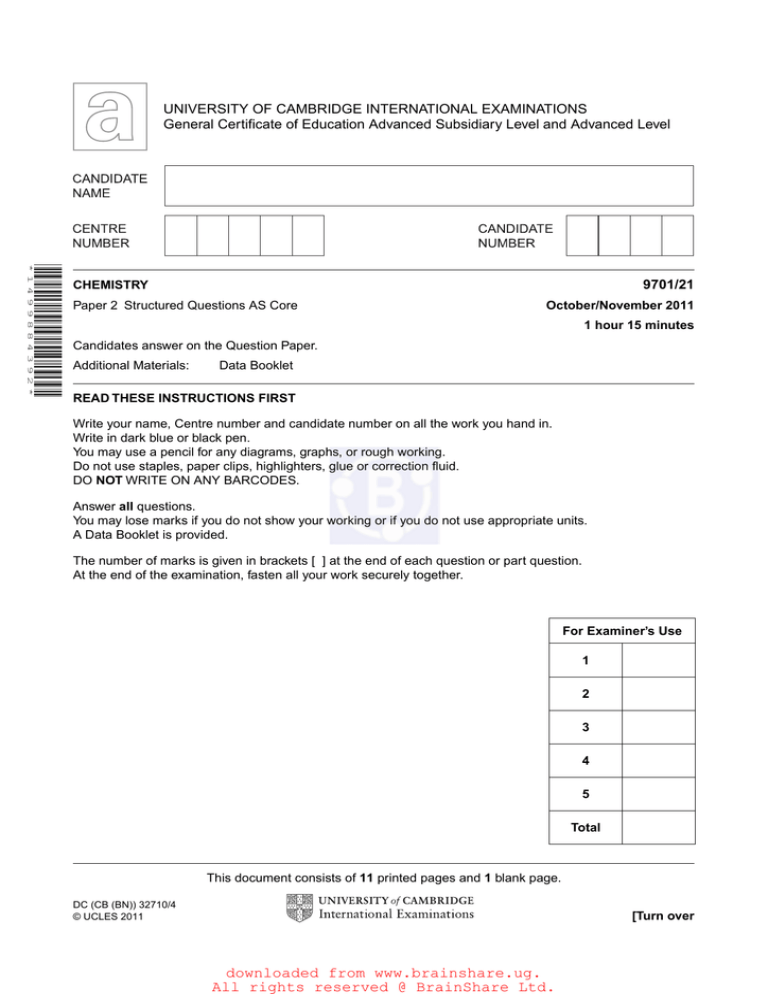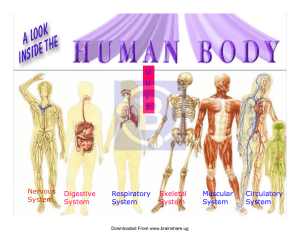
w
w
ap
eP
m
e
tr
.X
w
* 1 4 9 9 8 8 4 3 9 2 *
9701/21
CHEMISTRY
Paper 2 Structured Questions AS Core
October/November 2011
1 hour 15 minutes
Candidates answer on the Question Paper.
Additional Materials:
Data Booklet
READ THESE INSTRUCTIONS FIRST
Write your name, Centre number and candidate number on all the work you hand in.
Write in dark blue or black pen.
You may use a pencil for any diagrams, graphs, or rough working.
Do not use staples, paper clips, highlighters, glue or correction fluid.
DO NOT WRITE ON ANY BARCODES.
Answer all questions.
You may lose marks if you do not show your working or if you do not use appropriate units.
A Data Booklet is provided.
The number of marks is given in brackets [ ] at the end of each question or part question.
At the end of the examination, fasten all your work securely together.
For Examiner’s Use
1
2
3
4
5
Total
This document consists of 11 printed pages and 1 blank page.
DC (CB (BN)) 32710/4
© UCLES 2011
[Turn over
downloaded from www.brainshare.ug.
All rights reserved @ BrainShare Ltd.
om
.c
s
er
UNIVERSITY OF CAMBRIDGE INTERNATIONAL EXAMINATIONS
General Certificate of Education Advanced Subsidiary Level and Advanced Level
2
Answer all the questions in the space provided.
1
For
Examiner’s
Use
Compound A is an organic compound which contains carbon, hydrogen and oxygen.
When 0.240 g of the vapour of A is slowly passed over a large quantity of heated copper(II)
oxide, CuO, the organic compound A is completely oxidised to carbon dioxide and water.
Copper is the only other product of the reaction.
The products are collected and it is found that 0.352 g of CO2 and 0.144 g of H2O are
formed.
(a) In this section, give your answers to three decimal places.
(i)
Calculate the mass of carbon present in 0.352 g of CO2.
Use this value to calculate the amount, in moles, of carbon atoms present in 0.240 g
of A.
(ii)
Calculate the mass of hydrogen present in 0.144 g of H2O.
Use this value to calculate the amount, in moles, of hydrogen atoms present in 0.240 g
of A.
(iii)
Use your answers to calculate the mass of oxygen present in 0.240 g of A.
Use this value to calculate the amount, in moles, of oxygen atoms present in 0.240 g
of A.
[6]
© UCLES 2011
9701/21/O/N/11
downloaded from www.brainshare.ug.
All rights reserved @ BrainShare Ltd.
3
(b)
Use your answers to (a) to calculate the empirical formula of A.
For
Examiner’s
Use
[1]
(c) When a 0.148 g sample of A was vapourised at 60oC, the vapour occupied a volume of
67.7 cm3 at a pressure of 101 kPa.
(i)
Use the general gas equation pV = nRT to calculate Mr of A.
Mr =......................
(ii)
Hence calculate the molecular formula of A.
[3]
(d) Compound A is a liquid which does not react with 2,4-dinitrophenylhydrazine reagent or
with aqueous bromine.
Suggest two structural formulae for A.
[2]
(e) Compound A contains only carbon, hydrogen and oxygen.
Explain how the information on the opposite page about the reaction of A with CuO
confirms this statement.
..........................................................................................................................................
................................................................................................................................... [1]
[Total: 13]
© UCLES 2011
9701/21/O/N/11
downloaded from www.brainshare.ug.
All rights reserved @ BrainShare Ltd.
[Turn over
4
2
The Periodic Table we currently use is derived directly from that proposed in 1869 by
Mendeleev who had noticed patterns in the physical and chemical properties of the elements
he had studied.
The diagram below shows the first ionisation energies of the first 18 elements of the Periodic
Table.
2500
He
Ne
2000
first
ionisation
energy
/ kJ mol–1
1500
1000
500
0
Ar
H
Li
Na
0 1 2 3 4 5 6 7 8 9 10 11 12 13 14 15 16 17 18
proton number
(a) Give the equation, including state symbols, for the first ionisation energy of sulfur.
..................................................................................................................................... [2]
(b) Explain why there is a general increase in first ionisation energies across the Period
from sodium to argon.
..........................................................................................................................................
..........................................................................................................................................
..........................................................................................................................................
..................................................................................................................................... [3]
(c) (i)
Explain why the first ionisation energy of magnesium is greater than that of
aluminium.
..................................................................................................................................
..................................................................................................................................
..................................................................................................................................
(ii)
Explain why the first ionisation energy of phosphorus is greater than that of sulfur.
..................................................................................................................................
..................................................................................................................................
............................................................................................................................. [4]
© UCLES 2011
9701/21/O/N/11
downloaded from www.brainshare.ug.
All rights reserved @ BrainShare Ltd.
For
Examiner’s
Use
5
The table below refers to the elements of the third Period sodium to sulfur and is
incomplete.
element
Na
Mg
Al
conductivity
high
melting point
high
(d) (i)
(ii)
Si
P
For
Examiner’s
Use
S
Complete the ‘conductivity’ row by using only the words ‘high’, ‘moderate’ or ‘low’.
Complete the ‘melting point’ row by using only the words ‘high’ or ‘low’.
[5]
When Mendeleev published his first Periodic Table, he left gaps for elements that had yet
to be discovered. He also predicted some of the physical and chemical properties of these
undiscovered elements.
For one element, E, he correctly predicted the following properties.
melting point of the element
high
melting point of the oxide
high
boiling point of the chloride
low
The element E was in the fourth Period and was one of the elements from gallium, proton
number 31, to bromine, proton number 35.
(e) By considering the properties of the third Period elements aluminium to chlorine, suggest
the identity of the fourth Period element E.
.....................................
[1]
[Total: 15]
© UCLES 2011
9701/21/O/N/11
downloaded from www.brainshare.ug.
All rights reserved @ BrainShare Ltd.
[Turn over
6
3
For some chemical reactions, such as the thermal decomposition of potassium
hydrogencarbonate, KHCO3, the enthalpy change of reaction cannot be measured directly.
In such cases, the use of Hess’ Law enables the enthalpy change of reaction to be calculated
from the enthalpy changes of other reactions.
(a) State Hess’ Law.
..........................................................................................................................................
..........................................................................................................................................
..................................................................................................................................... [2]
In order to determine the enthalpy change for the thermal decomposition of potassium
hydrogencarbonate, two separate experiments were carried out.
experiment 1
30.0 cm3 of 2.00 mol dm–3 hydrochloric acid (an excess) was placed in a conical flask and the
temperature recorded as 21.0 °C.
When 0.0200 mol of potassium carbonate, K2CO3, was added to the acid and the mixture
stirred with a thermometer, the maximum temperature recorded was 26.2 °C.
(b) (i)
Construct a balanced equation for this reaction.
..................................................................................................................................
(ii)
Calculate the quantity of heat produced in experiment 1, stating your units.
Use relevant data from the Data Booklet and assume that all solutions have the
same specific heat capacity as water.
(iii)
Use your answer to (ii) to calculate the enthalpy change per mole of K2CO3.
Give your answer in kJ mol–1 and include a sign in your answer.
(iv)
Explain why the hydrochloric acid must be in an excess.
..................................................................................................................................
............................................................................................................................. [4]
© UCLES 2011
9701/21/O/N/11
downloaded from www.brainshare.ug.
All rights reserved @ BrainShare Ltd.
For
Examiner’s
Use
7
experiment 2
For
Examiner’s
Use
The experiment was repeated with 0.0200 mol of potassium hydrogencarbonate, KHCO3.
All other conditions were the same.
In the second experiment, the temperature fell from 21.0 °C to 17.3 °C.
(c) (i)
Construct a balanced equation for this reaction.
..................................................................................................................................
(ii)
Calculate the quantity of heat absorbed in experiment 2.
(iii)
Use your answer to (ii) to calculate the enthalpy change per mole of KHCO3.
Give your answer in kJ mol–1 and include a sign in your answer.
[3]
(d) When KHCO3 is heated, it decomposes into K2CO3, CO2 and H2O.
2KHCO3
K2CO3 + CO2 + H2O
Use Hess’ Law and your answers to (b)(iii) and (c)(iii) to calculate the enthalpy change
for this reaction.
Give your answer in kJ mol–1 and include a sign in your answer.
[2]
[Total: 11]
© UCLES 2011
9701/21/O/N/11
downloaded from www.brainshare.ug.
All rights reserved @ BrainShare Ltd.
[Turn over
8
4
But-1-ene, CH3CH2CH=CH2, is an important compound in the petrochemical industry.
For
Examiner’s
Use
(a) Some reactions of but-1-ene are given below.
In each empty box, draw the structural formula of the organic compound formed.
CH3CH2CH=CH2
H2O(g)
H3PO4 catalyst
MnO4– / H+
hot, concentrated
MnO4– / H+
cold, dilute
T
U
V
Cr2O72– / H+
heat under reflux
W
[5]
© UCLES 2011
9701/21/O/N/11
downloaded from www.brainshare.ug.
All rights reserved @ BrainShare Ltd.
9
(b) Compound T reacts with compound U.
For
Examiner’s
Use
Draw the displayed formula of the organic product of this reaction.
[2]
[Total: 7]
© UCLES 2011
9701/21/O/N/11
downloaded from www.brainshare.ug.
All rights reserved @ BrainShare Ltd.
[Turn over
10
5
Astronomers using modern telescopes of various types have found many molecules in
the dust clouds in space. Many of these molecules are those of organic compounds and
astronomers constantly look for evidence that amino acids such as aminoethanoic acid,
H2NCH2CO2H, are present.
One molecule that has been found in the dust clouds is hydroxyethanal, HOCH2CHO.
(a) Hydroxyethanal contains two functional groups.
(i)
Name, as fully as you can, each of the functional groups present in
hydroxyethanal.
1 .................................................................................
2 .................................................................................
(ii)
For each functional group, identify a reagent that will react with this group and not
react with the other functional group present.
In each case, describe what would be observed when this reaction is carried out.
functional group 1
reagent .......................................................
observation..................................................
functional group 2
reagent .......................................................
observation...................................................
[7]
(b) Give the skeletal formulae of the organic compounds formed when hydroxyethanal is
reacted separately with the following.
(i)
NaBH4
(ii) Cr2O72–/H+ under reflux conditions
[2]
© UCLES 2011
9701/21/O/N/11
downloaded from www.brainshare.ug.
All rights reserved @ BrainShare Ltd.
For
Examiner’s
Use
11
In a school or college laboratory, it is possible to convert a sample of hydroxyethanal
into aminoethanoic acid in a three-step process.
HOCH2CHO
step 1
X
step 2
Y
step 3
H2NCH2CO2H
By considering the possible reactions of the functional groups present in hydroxyethanal,
you are to deduce a possible route for this conversion.
(c) (i)
In the boxes below, draw the structural formulae of your suggested intermediates X
and Y.
X
(ii)
Y
State the reagents for each of the three steps you have chosen.
step 1......................................................
step 2......................................................
step 3......................................................
[5]
[Total: 14]
© UCLES 2011
9701/21/O/N/11
downloaded from www.brainshare.ug.
All rights reserved @ BrainShare Ltd.
For
Examiner’s
Use
12
BLANK PAGE
Permission to reproduce items where third-party owned material protected by copyright is included has been sought and cleared where possible. Every
reasonable effort has been made by the publisher (UCLES) to trace copyright holders, but if any items requiring clearance have unwittingly been included, the
publisher will be pleased to make amends at the earliest possible opportunity.
University of Cambridge International Examinations is part of the Cambridge Assessment Group. Cambridge Assessment is the brand name of University of
Cambridge Local Examinations Syndicate (UCLES), which is itself a department of the University of Cambridge.
© UCLES 2011
9701/21/O/N/11
downloaded from www.brainshare.ug.
All rights reserved @ BrainShare Ltd.







